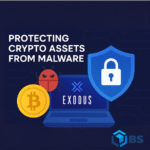Now Reading: 🛑 7 Warning Signs: How to Identify Fake Cryptocurrency & Scam Coins Before You Invest
-
01
🛑 7 Warning Signs: How to Identify Fake Cryptocurrency & Scam Coins Before You Invest
🛑 7 Warning Signs: How to Identify Fake Cryptocurrency & Scam Coins Before You Invest

Knowing how to identify fake cryptocurrency and scam coins is crucial for any crypto investor. Crypto-related fraud is skyrocketing – for example, fraud losses reached $5.6 billion in 2023 according to the FBI rbcwealthmanagement.com. Scammers lure victims with flashy websites and promises of easy money, but their schemes can wipe out life savings. This comprehensive guide will break down common scam tactics, spotlight big fraud examples (OneCoin, rug-pulls, etc.), and show practical steps to protect your funds. By the end, you’ll have the knowledge to spot red flags in cryptocurrency projects and avoid falling for the biggest crypto scams.
Understanding Fake Cryptocurrency and Scams
Cryptocurrency is decentralized digital money – but this openness also attracts fraudsters. Fake or scam cryptocurrencies often come in many forms: entirely bogus “coins” with no real network, Ponzi/MLM schemes, or even legitimate coins spoofed by fakes. Scammers may clone a popular coin’s name or mimic its website to trick newcomers. They count on the fact that many still believe “crypto currency is a scam,” a phrase often used by critics. Ironically, this skepticism becomes part of the con: a scammer might proclaim “cryptocurrencies are scams” while pushing their own fake project as an exception.
While some doubt the whole crypto space, many legitimate blockchain projects do exist. The key is learning to differentiate real from fake. Some warning signs are obvious (like guaranteed 100% returns), others subtle. For instance, the FBI warns that OneCoin was not a real coin at all but a massive fraud fbi.gov. OneCoin marketed itself as the next Bitcoin but was just a multi-level marketing scam, fleecing people out of over $4 billion binance.comfbi.gov. Likewise, today’s “Pi Network” (sometimes called a Pi coin scam by critics) relies on pyramid-like referrals and still hasn’t launched a tradable token, raising red flags cointelegraph.com.
Key Point: Fake cryptocurrency scams vary, but they all rely on deception. Stay aware that any coin or platform – no matter how slick the website – could be a scam. Always verify facts independently.
Common Crypto Scam Tactics and Examples
Scammers use many tactics to steal money. Familiarize yourself with these common crypto scams so you can recognize them:
- Fake Exchanges and Wallets: Criminals create phishing sites that look like real exchanges or wallets. For example, they might clone Binance or Coinbase login pages. Always double-check URLs and SSL certificates. If an exchange is brand-new or unknown, it may be on a fake exchange list of scam sites. Brainstak’s 2025 list of fake crypto exchanges warns investors to avoid dozens of these fraudulent platforms.
- Phony Guarantees: Promises of guaranteed returns or free “airdrops” are major red flags. No financial investment can guarantee profits. As Kaspersky notes, any crypto that “promises you will definitely make money is a red flag”usa.kaspersky.com. Be especially wary of “get-rich-quick” claims, multi-level marketing bonuses, or referral rewards that sound too good to be true. In fact, schemes promising consistent high yields (like classic Ponzi setups) have cost investors billions binance.com.
- Anonymous or Unverifiable Teams: Legitimate cryptocurrency projects provide clear info about their founders and developers. If a coin’s website lists no team, uses stock photos, or provides only first names, consider it suspicious usa.kaspersky.com. For example, OneCoin hid its founder’s identity for years – Ruja Ignatova (“Cryptoqueen”) eventually vanished as authorities closed in fbi.gov. Always search for team members’ LinkedIn profiles or past work. If none can be found, or their credentials look fake, do not invest.
- Poor or Missing Whitepaper: Most real crypto projects publish a whitepaper that details the technology and roadmap. A fake coin may offer no whitepaper at all, or one that’s poorly written, plagiarized, or full of buzzwords. Kaspersky points out that if the whitepaper “doesn’t exist – then tread carefully”usa.kaspersky.com. Without a whitepaper explaining how a coin works, you’re basically gambling on smoke.
- Heavy Hype and Marketing: Scammers burn cash on slick ads and social media hype to pump up a worthless token fast. They may hire influencers or spam Twitter/Telegram. If you notice heavy marketing with extravagant claims but no substance, be cautious usa.kaspersky.com. Remember the Squid Game coin: it piggybacked on a Netflix hit, soared to $2,861, then crashed to almost zero within days as developers “cashed out” – a textbook pump-and-dump bankrate.com.
- Pump-and-Dump / Rug Pulls: New “DeFi” or niche coins on small exchanges can be especially dangerous. A fraudster might sell you a token they control, then suddenly withdraw all liquidity (a rug pull), leaving your “investment” worthless. RBC warns of these “pump-and-dump” schemes, where promoters inflate a coin’s price, take investors’ money, and shut down the project rbcwealthmanagement.com. The 2021 “Squid Game” coin is a famous example, but there are thousands of smaller rug pulls happening constantly.
- Copycat Branding: Be alert for coins that copy names or logos of well-known projects. For example, a scam coin might use the old Facebook/Meta “Libra” name or an misspelling like “Rippple”. Also watch for fake celebrity endorsements on social media. Kaspersky explains scammers often use unauthorized images of famous people (Elon Musk, celebrities) to make a scam coin look legitimate usa.kaspersky.com. If you see a celebrity promo, verify it on their official channels – most scammers are frauds.
- Impersonation and Phishing: Scammers sometimes pose as customer support or known figures in crypto. They might DM you on Telegram, email fake login links, or blackmail you with false claims. Never share your private keys or login credentials. Kaspersky explicitly advises to ignore cold calls and unsolicited crypto offers usa.kaspersky.com. If you get an email claiming you won a giveaway or need to “verify” your account, treat it as a scam attempt.
- Emotional Tactics: Scammers prey on emotions. They might invoke FOMO (“this coin will moon overnight”) or fear (“all crypto is a scam except this”). They sometimes use romantic or emergency stories to manipulate victims (RBC notes even romance and blackmail scams in crypto rbcwealthmanagement.com). In any case, if someone is strong-arming you to act now or is making you feel scared or overly excited, step back and verify everything independently.
Historical Examples: Learning from past frauds can sharpen your senses. Some of the biggest crypto scams include:

- OneCoin (2014–2019): Marketed as “Bitcoin Killer,” but with no actual blockchain. It was a pyramid scheme under the guise of crypto, defrauding investors of an estimated $4.4 billion binance.comfbi.gov. Its founder, Ruja Ignatova, is still at large.
- BitConnect (2016–2018): A supposed “crypto lending” platform promising absurd returns via a fake trading bot. It attracted billions but collapsed, revealing a Ponzi structure binance.com.
- PlusToken (2018–2019): Marketed as a wallet app delivering high returns through “arbitrage”. It turned out to be China’s largest crypto fraud, scamming over $2 billion binance.com.
- TerraUSD (2022): An algorithmic stablecoin that crashed from $1 to near $0, wiping out $40+ billion in a week. This wasn’t a hacker attack but poor design: it highlights that even well-known projects can fail without warning bankrate.com.
- FTX (2022): Once the third-largest crypto exchange, it secretly diverted customer funds to its hedge fund Alameda Research. When this fraud was exposed, the exchange collapsed and its founder was jailed for fraud bankrate.com. Though FTX was an exchange, not a coin, its downfall is a reminder that misuse of crypto funds is common.
- Squid Game Coin (2021): A meme token that skyrocketed on hype from the Netflix show “Squid Game.” Within days, developers disappeared with $3.36 million of investor funds and the price crashed to pennies bankrate.com. It’s the textbook definition of a rug pull.
- $LIBRA Scam (2025): In early 2025, a crypto coin called LIBRA (unrelated to Facebook’s old project) popped up in Argentina. Promoted on social media by insiders, it surged on hype then plunged ~90% in hours as insiders dumped $250 million bankrate.com. This was a media-covered “biggest crypto scam” in South America.

These cases illustrate how diverse crypto scams can be. The takeaway? Always approach new crypto offers with extreme skepticism. Use these examples to inform your caution.
How to Identify Fake Cryptocurrency: Key Warning Signs
To avoid falling for scams, train yourself to look for red flags in any crypto project. Here are some of the clearest signs a coin might be fake or fraudulent:
- Promises of Guaranteed Returns: This is the biggest red flag. As the cybersecurity guide notes, “No financial investment can guarantee future returns”usa.kaspersky.com. If a crypto offering says “invest $1,000 today and get $2,000 tomorrow,” it’s almost certainly a scam. Legitimate projects focus on technology and use-cases, not payday guarantees.
- Unrealistic Marketing Hype: Watch out for over-the-top marketing. If a project’s promotion relies heavily on buzzwords and slick videos but lacks solid details, be wary. Kaspersky advises skepticism when you see heavy advertising making extravagant claims usa.kaspersky.com. For example, if every channel you visit shows ads screaming “1000% ROI, Elon Musk approves!”, pause and research before you rush in.
- Anonymous or Missing Team: Legitimate crypto teams want to be known and creditable. If you can’t find credible information about the founders, devs, or advisors, that’s a warning. Fake projects often have “unnamed team members”, with no bios or verifiable identities usa.kaspersky.com. Always google the team: if all you find are empty LinkedIn profiles or unrelated social media accounts, be very suspicious.
- No or Terrible Whitepaper: A whitepaper is the project’s roadmap. If there’s no whitepaper or it’s filled with jargon and no clear plan, that’s a critical warning sign usa.kaspersky.com. A real crypto will have a whitepaper (and often a GitHub) explaining its technology. For instance, Ethereum and Bitcoin have well-known whitepapers; if your coin doesn’t, it probably shouldn’t be invested in.
- Closed Source or No Code: Check if the coin’s code is visible. On platforms like GitHub, legitimate projects often publish smart contracts or client code. If the developers hide the code, or it’s a simple copy of an existing project, consider it unsafe. A reputable project should welcome code audits; scammers bury their code. You can also use blockchain explorers: see if the token’s transactions and supply make sense, or if the “project” has no real blockchain activity.
- Outlandish Use Cases: Does the project’s goal seem reasonable? Some scam coins claim they will “solve world hunger with blockchain” or “be the universal currency used by governments.” While ambitious ideas aren’t inherently scams, really grandiose claims with no proof tend to indicate a lack of substance. If it sounds too magical, dig deeper.
- Excessive Secrecy: If project leaders refuse to answer basic questions publicly or hide behind shadowy corporate structures, be on guard. Real crypto projects usually hold community AMAs or publish updates. Scams will dodge questions. For example, if you ask “How exactly do you generate profit for investors?” and get a vague response or are banned, the project likely has something to hide.
- Free Money or Giveaways: “We’ll match any crypto you send us!” or similar giveaway schemes are always scams. There is no legitimate “crypto giveaway” that requires you to send funds first. Never send crypto to anyone expecting more back.
- Regulatory Red Flags: Check for things like disclaimers and legal compliance. If a site claims it’s completely legal but provides no licenses or shows no understanding of regulations, it’s dodgy. Many scams avoid any mention of regulation. Also, beware of coins promising to bypass regulations or being “untraceable.” Usually, that means they’re shielding illegal operations.

In summary, if any of these warning signs appear – especially in combination – it’s best to steer clear. Remember what Kaspersky and others say: “Take your time and carry out your own research before investing”usa.kaspersky.com. Never let high-pressure tactics or hype override your judgment. When in doubt, ask more questions or consult experienced community members before putting in money.
How to Research and Verify Cryptocurrency Projects
Spotting scams also means doing your homework. Here are concrete steps to validate a crypto project:
- Use Reputable Platforms: Start with trusted sources. For example, search for the coin on known aggregators like CoinMarketCap or CoinGecko. If it’s not listed there, that’s a red flag. Stick to major exchanges and wallets for transactions. (For guidance on wallets, see our guide on how to create a crypto wallet rbcwealthmanagement.com.) Always download wallets from official app stores or project sites.
- Read the Whitepaper: Carefully read the project’s whitepaper or technical documentation. It should clearly explain the technology, tokenomics (how tokens are distributed), and use cases. If the whitepaper is poorly written, copied from other projects, or is just a marketing brochure, be skeptical usa.kaspersky.com. A whitepaper should be detailed and coherent.
- Verify the Team: Look up the founders and developers. Check LinkedIn, past experience, GitHub contributions. A real team will often have a history in tech or crypto. If you can’t find any solid info on the team, or if their online presence seems fake, do not invest.
- Check External News and Reviews: Search for the coin’s name plus “review,” “scam,” or “news” in quotes. If it’s legitimate, there might be articles or forum discussions. If all you find are pump pieces or forum spam, be cautious. Conversely, look for any news of hacks or warnings. For example, the Massachusetts government publishes known crypto scams mass.gov – see if the project is listed anywhere.
- Inspect the Code: If it’s an Ethereum (ERC-20) or other smart-contract token, check Etherscan or BscScan. View the token’s contract code (if verified on Etherscan) to see if it’s a simple copy of another token or contains malicious functions (like minting infinite tokens). Also check if the token is immediately transferable or if it’s locked/paused (sometimes locked tokens hide malicious behavior). If the code is inaccessible or seems suspicious, skip it.
- Community and Social Presence: Visit the project’s social media – Twitter, Telegram, Discord. See how active and genuine the community is. Are there independent discussions (not just the project’s marketing team), or is it all shilled content? Genuine projects have debates on Reddit or Bitcointalk. If the only comments are bots or endless “to the moon!” posts, that’s a bad sign.
- Security Audits: Check if the project has undergone any third-party audits by security firms. Audits are not mandatory, but reputable projects often pay for them to build trust. If an audit report is available, skim it for any critical issues flagged.
- Due Diligence on Technology: Understand how the crypto is mined or distributed. For instance, if it’s proof-of-work, is there a known mining software? If it’s proof-of-stake or some new consensus, do you understand it? If this is unclear or proprietary-sounding, it could be a trick. Remember, Kaspersky’s advice: “Only invest in things you understand”usa.kaspersky.com.
- Use Small Test Transactions: If you decide to try it out, never go in with a large sum first. Use the advice from Kaspersky: transfer a tiny amount to test the process usa.kaspersky.com. For example, if sending crypto to an exchange, send $1 worth first and try to withdraw. If that fails, something is wrong.
Throughout this research, keep the focus keyword in mind: “how to identify fake cryptocurrency” means you’re actively looking for inconsistencies. There’s no foolproof checklist, but each of these steps adds a layer of confidence. If at any point your due diligence raises doubt, it’s safer to walk away. As RBC Wealth Management warns, “Never invest in a new cryptocurrency … without doing thorough research”rbcwealthmanagement.com.
Protecting Your Investments

Even after you’ve invested in legitimate crypto, continue to protect your assets and information:
- Secure Your Wallet: Use hardware or reputable software wallets and always back up your seed phrases. Brainstak’s guide on creating a crypto wallet covers this. Set strong, unique passwords and enable two-factor authentication (2FA) on exchanges. RBC notes that “anyone who gains access to your private keys will immediately have access to your crypto”rbcwealthmanagement.com, so never share them or store them insecurely.
- Stay Updated on Security Threats: Follow trusted crypto news sources or communities. For example, subscribe to Brainstak’s Crypto Market Update (May 2025) to learn about the latest trends and threats. The recent Exodus desktop wallet hack (2024) is a cautionary example: even well-known wallets can be targeted rbcwealthmanagement.com. Always update your wallet/app/software when patches are released.
- Use Only Reputable Exchanges: When buying or trading, stick to well-known exchanges. New or shady exchanges may themselves be fraudulent (or easily hacked). Brainstak’s list of fake crypto exchanges can help you avoid known scams. Don’t trust exchanges promoted via random ads or DMs.
- Diversify and Don’t Overexpose: As a general rule, don’t bet everything on a single project. Spread your holdings across Bitcoin, Ethereum, and a few vetted altcoins, if at all. That way, if one coin turns out to be a dud (or a scam), you haven’t lost everything. The old adage “don’t put all your eggs in one basket” applies strongly in crypto.
- Be Skeptical of Social Media and Phishing: Crypto scammers love Twitter, Telegram, and Discord. Never click suspicious links. If someone on social media claims to be a project member and asks for information or funds, verify through official channels first. Kaspersky warns to treat cold calls and offers with extreme caution usa.kaspersky.com. Remember that real project teams will not DM random people first or ask for private info.
- Know How to Report Scams: If you do encounter a scam, report it to authorities. The FBI’s IC3 is a place to report crypto fraud. While this doesn’t recover your money, it helps build evidence against scammers. Reporting also protects the community by raising awareness.
- Don’t Panic in Volatile Markets: Finally, emotional reactions can lead to mistakes. Market volatility (e.g. a sudden crash in Bitcoin’s price) might make some coins look like scams if they dip sharply. That’s different from an actual scam where the coin’s fundamentals are false. Distinguish between market crashes (affect legit and scam coins alike) and exit scams (where the project disappears or stops trading).
- Continue Educating Yourself: The crypto space evolves fast. New scam tactics appear regularly. Keep learning. There are many resources online; for instance, we referenced the FBI’s report and security articles here. Engage in crypto communities (like Reddit’s r/CryptoCurrency) and share knowledge. Education is your best defense.

By combining solid security practices with the warning signs learned above, you greatly reduce your risk. As the RBC article advises: stay informed and do your due diligence rbcwealthmanagement.com – if something sounds off, it probably is.
Conclusion
Detecting a fake cryptocurrency before you invest requires caution, research, and skepticism. Always remember that if a crypto pitch sounds too good to be true, it probably is. We’ve covered how scammers operate, outlined the warning signs to look for, and given you specific tips for verifying projects. Real-world cases like OneCoin, BitConnect, and numerous rug pulls highlight the kinds of schemes to avoid binance.combankrate.com.

In short, follow these principles: always question grand claims, verify every detail, and use trusted sources. Protect your keys and only invest what you can afford to lose. Stay curious and informed – knowing how to identify fake cryptocurrency will help you avoid becoming a victim of the next big crypto scam. As you continue your crypto journey, revisit these guidelines and help others by spreading awareness. The crypto world rewards caution and education, so keep learning and stay safe.



























